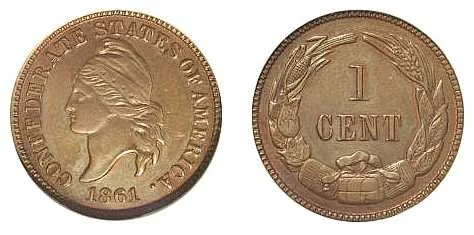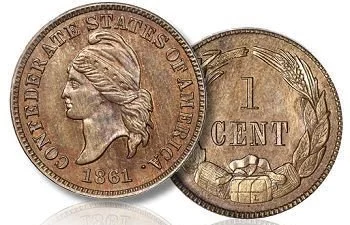Uncommon Cents: The 1861 Confederate Cent
The 1861-O silver Half Dollar wasn't the only coin officially sanctioned by the Confederacy. Sometime in 1861, an agent of the CSA made inquiries with the Philadelphia jewelry firm of Bailey & Co. as to the availability of a die-cutter who could also design coins.
He was directed to John Lovett Jr., an accomplished engraver who accepted the commission to produce a trial run of one cent pieces in the same copper-nickel alloy as was currently being used by the Union for their pennies. To save time and effort, Lovett used a likeness of Minerva that he had designed for use on a store card he used to advertise his services. Minerva was the goddess of war and wisdom, in fact the Roman version of the Greek goddess Athena.
The design of the cent is simple, elegant, and typical for its time. On the obverse, Minerva wears a Phrygian Cap signifying Liberty. The cap's band has six stars.
The legend "CONFEDERATE STATES OF AMERICA" and the date of 1861 circle the field inside the rim. The reverse features a cereal wreath formed from sprigs of corn and cotton on the left, wheat and tobacco on the right.
The lower part of the wreath is tied with a ribbon and partly hidden behind two barrels and a bale of cotton. Lovett placed a small letter "L" on the lower right portion of the cotton bale to credit himself. In the center of the reverse was the "1 CENT" denomination. All in all, it's a very attractive design that compares well with the classic Indian Head cent minted from 1859 through 1909.
Lovett struck only 12 trial pieces, then buried the coins and dies in his basement. According to Lovett (as per John W. Haseltine), "...his wife became timid about his delivering them for fear that the United States government would arrest him for giving assistance to the enemy."
There was no further contact with or from the CSA, and after the war Lovett took to carrying around one of the Confederate cents as a pocket piece. Fate would have it that one day (or night) in 1873, Lovett accidentally spent his good luck charm at a Philadelphia bar. The bartender noticed the unusual coin and showed it to a friend of his who was a numismatist.
Eventually, Captain John W. Haseltine got wind of the coin's existence. Haseltine spoke on the matter at the 1908 American Numismatic Convention thusly: "I knew by the head on the obverse that it was Mr. Lovett's work. I called on Mr. Lovett and he denied ever having made such dies. At numerous times I called to induce him to give me some information about them, but he always stuck to his story that he did not make them, until one day he pulled out a drawer in one of his cabinets and I beheld a line of little Confederate cents. He then owned up and told me that he had eleven of them but formerly there were twelve, he having lost one."
1861 Confederate Cent, 1874 Haseltine restrike in gold
Haseltine ended up purchasing the coins and dies, and arranged for Confederate cents to be restruck. Seven were struck in gold, twelve in silver, and 55 in copper with the die shattering while striking the 55th coin.
He auctioned off some of the original copper-nickel cents. The listing for the first coin to be auctioned by Thomas Birch & Sons in 1874 read, in part: "Although it is evident that the Southern Confederacy did not adopt this piece, still it will always be considered interesting and valuable as the only coinage designed for the Southern Confederacy, and will no doubt bring a high price."
One of those original twelve Confederate Cents was auctioned on May 26th, 2005 by Stack's. By the time the hammer came down, the price had reached an amazing $110,000... enough to cover more than a few bar tabs.
by Steve Levenstein, 2005 ©RLinc



